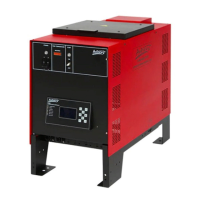CAUTION: To prevent damage to components
(hose fittings, etc.), the system, specifically the part
being serviced, should be heated to approximately
250 °F prior to dismantling, assembly, or
adjustment. Failure to do this will result in stripping
of threads and ruining both parts and tools. To avoid
arcing of electrical contacts and possible failure of
components, do not connect hose or head electrical
connectors when the power switch is ON.
6.2.2 Heating of Parts
Heating parts may be accomplished by:
• Applying power to the melt unit.
• Using a hand held hot air gun.
6.2.3 Monthly Inspection Procedure
Hose Inspection
1. Verify that the hose is being properly supported so it is not
over-stressed during use. Minimum bend radius is 8 inches
when hot.
2. Check temperatures and adjust as explained in section 5.3.
NOTE: On multihose systems, a temperature imbalance between
hoses can be quickly found by feeling the outside insulation of
each hose.
Supply hose Temperature Check
A supply hose temperature check should only be done if there is
reasonable doubt that the supply hose is not heating properly. To
do a supply hose temperature check, it is necessary to probe one
end of the supply hose. The supply hose must remain electrically
connected to the melt unit. This means extreme caution and
protection should be used because the supply hose is physically
hot. Removing the applicator head from the supply hose or
removing the supply hose from the melt unit are two methods for
doing a supply hose temperature check. The procedure for
removing the applicator head from the supply hose is described
below. The method for removing the supply hose from the unit is
described in the Heated Supply Hose manual.
1. Switch Off the pump motor switch.
2. Depressurize the system by activating the head until glue stops
flowing.
!
© Copyright Astro Packaging 2009 KB30, KB50 and KB100 Series Hot Melt Units 19600-159 Rev. A 04/09/09 25

